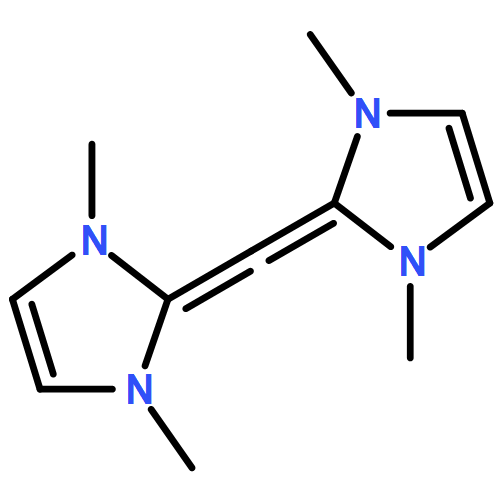Abstract
Quantum-chemical calculations with DFT (BP86) and ab initio methods [MP2, SCS-MP2, CCSD(T)] have been carried out for the molecules C(PH3)2 (1), C(PMe3)2 (2), C(PPh3)2 (3), C(PPh3)(CO) (4), C(CO)2 (5), C(NHCH)2 (6), C(NHCMe)2 (7) (Me2N)2C![[DOUBLE BOND]](http://onlinelibrarystatic.wiley.com/undisplayable_characters/00f8fe.gif) C
C![[DOUBLE BOND]](http://onlinelibrarystatic.wiley.com/undisplayable_characters/00f8fe.gif) C(NMe2)2 (8), and NHC (9), where NHC=N-heterocyclic carbene and NHCMe=N-methyl-substituted NHC. The electronic structure in 1–9 was analyzed with charge- and energy-partitioning methods. The results show that the bonding situations in L2C compounds 1–8 can be interpreted in terms of donor–acceptor interactions between closed-shell ligands L and a carbon atom which has two lone-pair orbitals L
C(NMe2)2 (8), and NHC (9), where NHC=N-heterocyclic carbene and NHCMe=N-methyl-substituted NHC. The electronic structure in 1–9 was analyzed with charge- and energy-partitioning methods. The results show that the bonding situations in L2C compounds 1–8 can be interpreted in terms of donor–acceptor interactions between closed-shell ligands L and a carbon atom which has two lone-pair orbitals L![[RIGHTWARDS ARROW]](http://onlinelibrarystatic.wiley.com/undisplayable_characters/002192.gif) C
C![[LEFTWARDS ARROW]](http://onlinelibrarystatic.wiley.com/undisplayable_characters/002190.gif) L. This holds particularly for the carbodiphosphoranes 1–3 where L=PR3, which therefore are classified as divalent carbon(0) compounds. The NBO analysis suggests that the best Lewis structures for the carbodicarbenes 6 and 7 where L is a NHC ligand have C
L. This holds particularly for the carbodiphosphoranes 1–3 where L=PR3, which therefore are classified as divalent carbon(0) compounds. The NBO analysis suggests that the best Lewis structures for the carbodicarbenes 6 and 7 where L is a NHC ligand have C![[DOUBLE BOND]](http://onlinelibrarystatic.wiley.com/undisplayable_characters/00f8fe.gif) C
C![[DOUBLE BOND]](http://onlinelibrarystatic.wiley.com/undisplayable_characters/00f8fe.gif) C double bonds as in the tetraaminoallene 8. However, the Lewis structures of 6–8, in which two lone-pair orbitals at the central carbon atom are enforced, have only a slightly higher residual density. Visual inspection of the frontier orbitals of the latter species reveals their pronounced lone-pair character, which suggests that even the quasi-linear tetraaminoallene 8 is a “masked” divalent carbon(0) compound. This explains the very shallow bending potential of 8. The same conclusion is drawn for phosphoranylketene 4 and for carbon suboxide (5), which according to the bonding analysis have hidden double-lone-pair character. The AIM analysis and the EDA calculations support the assignment of carbodiphosphoranes as divalent carbon(0) compounds, while NHC 9 is characterized as a divalent carbon(II) compound. The L
C double bonds as in the tetraaminoallene 8. However, the Lewis structures of 6–8, in which two lone-pair orbitals at the central carbon atom are enforced, have only a slightly higher residual density. Visual inspection of the frontier orbitals of the latter species reveals their pronounced lone-pair character, which suggests that even the quasi-linear tetraaminoallene 8 is a “masked” divalent carbon(0) compound. This explains the very shallow bending potential of 8. The same conclusion is drawn for phosphoranylketene 4 and for carbon suboxide (5), which according to the bonding analysis have hidden double-lone-pair character. The AIM analysis and the EDA calculations support the assignment of carbodiphosphoranes as divalent carbon(0) compounds, while NHC 9 is characterized as a divalent carbon(II) compound. The L![[RIGHTWARDS ARROW]](http://onlinelibrarystatic.wiley.com/undisplayable_characters/002192.gif) C(1D) donor–acceptor bonds are roughly twice as strong as the respective L
C(1D) donor–acceptor bonds are roughly twice as strong as the respective L![[RIGHTWARDS ARROW]](http://onlinelibrarystatic.wiley.com/undisplayable_characters/002192.gif) BH3 bond.
BH3 bond.
